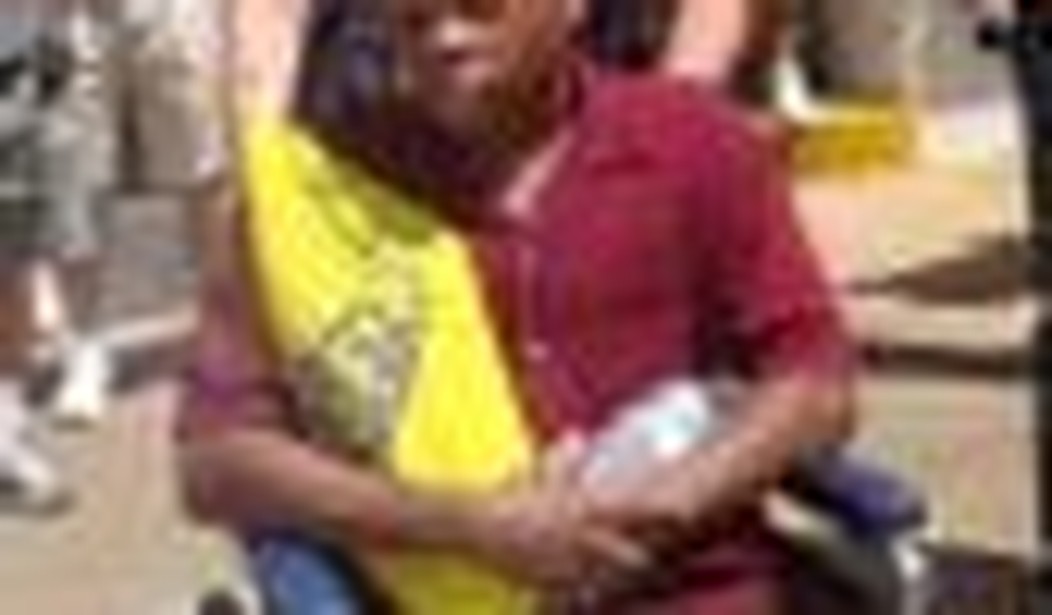There’s nothing that liberals hate more than a black person who achieves success without their help. While the president of the United States gets worked up about a policeman who arrests a clearly out-of-control “scholar” (Henry Louis Gates Jr.) who enjoys a cushy job advancing the notion that blacks were, are, and always will be victims, he says nothing about his close supporters, SEIU thugs, ganging up on a black man trying to sell merchandise at an August health care town hall. Professors who refuse to teach Huckleberry Finn because of its realistic dialogue ignore the fact that eyewitnesses heard the N-word hurled at Kenneth Gladney, the 39-year-old man for whom the wheels of justice have stopped. The original misdemeanor charges have been reduced to an ordinance violation.
But the ignoring of an unprovoked beating of a black man fits into the racist history of the left. They have been successful in propagandizing the idea that their efforts led to civil rights laws and integration. But a look at the past, namely of their predecessors, the communists, reveals a pattern of using black people for their larger goals. This history, though, is being censored by those in control of education — radical professors like Bill Ayers.
Much has been said about Ayers’ (and fellow 1960s radicals’) terroristic past, but little has been said about his racist views. But his views are the left’s in a nutshell; they explain why Gladney is being ignored.
Ayers is one of the 1960s radicals who have exploited race to advance his own career. White liberals use blacks they “help” to prove their own virtue — and to get tenure, awards, consulting jobs, political office, etc. Although they “help” others — like indigenous peoples, traumatized soldiers, women, and schoolchildren — the black person has always provided the best photo-op for the racist white person.
Ayers’ latest book, coauthored with wife Bernardine Dohrn, Race Course Against White Supremacy, reveals an agenda to dismantle capitalism through claims of its inherent racism. But Ayers’ 2001 memoir, Fugitive Days, reveals his racism too.
Like Barack Obama, Ayers was a community organizer. This son of privilege decided to minister among the benighted denizens of Cleveland and begins chapter 11 with his typically melodramatic style:
Whenever I hear the thwack-thwacking of a helicopter overhead, or the frantic approach of sirens in the night, I think back to Cleveland, 1966.
I remember a solemn line of troops early one morning marching noisily up Euclid Boulevard in full battle gear, bayonets fixed, rubber gas masks mutating each soldier into a monster from space, their tall black boots stomping on the pavement, their tin canteens and ammunition belts beating out a syncopated response.
Ayers sees himself as the heroic “freedom fighter” of this romantic narrative. But the worst he suffers as he participates in the rioting he helps instigate is being tear-gassed and getting a broken finger.
As if he were Martin Luther King Jr. sitting in Birmingham Jail, he writes about why he is in Cleveland:
The Community Union was part of a joint national strategy of SDS and SNCC, the beginning of a shift away from attacking the legal barriers to integration largely in the South … toward organizing around de facto segregation and economic injustice everywhere.
Ayers, like many of those who had the time and means to “organize” those who do not realize their oppression, has a curious way of looking at “poor people”: “Our focus was on building a powerful force of poor people in big northern cities — the grassy grassroots, we called them — who could not only change their own lives but could change the world.” Changing the world, to a communist utopia, of course, was the goal.
He continues, “Our slogan was ‘Let the People Decide,’ and our plan was to live among the poor, to share their travails and their triumphs, then to build action and organization around issues of broad and shared concern: tenant and welfare rights, for example, safety and police brutality, education and schools, racial discrimination.” Notice that there is nothing about jobs or building businesses or strengthening families. And of course the people could decide — as long as their decisions matched those of Ayers and company.
The “grassy grassroots” were then gathered into mobs in order to bring down the capitalist structure. This is what original community organizer Saul Alinsky did in Rochester, New York, when he deliberately undermined efforts already underway by the city’s biggest employer, Kodak, to recruit and move blacks up the ranks through training programs. Alinsky writes in Rules for Radicals that after the 1964 riots, “the city [Rochester] was numb with shock. A city proud of its affluence, culture, and progressive churches was dazed and guilt-ridden at its rude discovery of the misery of life in the ghetto.” He then tells about being approached by the City Council of Churches: “I advised the church council of the cost. … The council agreed to the cost and ‘invited’ us to come in and organize.” Alinsky’s biographer, Sanford Horwitt, describes Alinsky’s fee — in 1964 — as $100,000. I wonder how many of those putting money in the collection plates knew that their contributions were going to bring in an atheist “organizer” who writes, “The job of the organizer is to maneuver and bait the establishment so that it will publicly attack him as a ‘dangerous enemy’” — identified with the “have-nots,” “the people.”
The community organizer then obtains power because the establishment fears him: “We find that it is power and fear that are essential to the development of faith.”
The faith transfers over to the organizer: “The organizer’s job is to inseminate an invitation for himself, to agitate, introduce ideas, get people pregnant with hope and a desire for change and to identify you as the person most qualified for this purpose” (emphases added). Kenneth Gladney obviously did not fall for the latest incarnation of “hope” and “change.”
Alinsky admits to stirring up the dissatisfaction that leads to the invitation to “organize”: “The tool of the organizer, in the agitation leading to the invitation as well as actual organization and education of local leadership, is the use of the question.” The questions are intended to stir up dissatisfaction among the proletariat; this is exactly what ACORN organizers do. The organizer then becomes the hallowed leader of the mob making demands for “change.”
Alinsky had no qualms in making black people look like buffoons; at one protest at the symphony, they were fed beans so they would all have gas at the same time. Someone like Kenneth Gladney, who does not join the mob, who instead supports capitalism, is reviled.
Alinsky left Rochester a city more divided than ever. The working-class whites I lived among at the time, who were forced to work under less qualified blacks, were justifiably resentful. The efforts of those like Alinsky and Ayers undermined the religious and family ties in the black community, leading to illegitimacy and more crime — and thus confirming whites’ fears. Of course, Ayers and Alinsky do not have to live permanently in the neighborhoods they create. My family and I did and watched our neighborhood decay into a war zone. The black neighborhoods that abutted our working-class neighborhood were destroyed too.
But Alinsky was paid well for his efforts and Ayers earns over $126,000 per year as a professor, not to mention his lecture fees and royalties.
Ayers writes, “We were certain that struggling in the interest of these forgotten people crushed at the bottom held the key to social transformations that would shake the whole world to its core and ultimately benefit everyone.”
In the tradition of Mao, Lenin, Chavez, and every other dictator of the proletariat, the peasants are courted to usher in “social transformations.”
(The other thing Ayers used black people for was sex. Amidst the descriptions of efforts to “smash monogamy” through orgies are his daring relationships with black girlfriends.)
And in Ayers’ “scholarship” there is the determined thinly disguised effort to continue these efforts through a “social justice” curriculum. The Chicago Annenberg Challenge, which Ayers directed and on whose board Barack Obama sat, did nothing to advance test scores — or to help the “crushed” and “forgotten” children make better lives for themselves. In fact, Ayers’ curriculum is designed to divest children of logical and independent thought and the skills to succeed. It is designed to make black children permanently dependent upon those like Ayers.
But Ayers and company have presented themselves as the opposite of what they are and have managed to put this narrative into the public mind. Perhaps it was easier when such people were openly communist. Writers like Richard Wright, Chester Himes, and Ralph Ellison quickly caught on to the real agenda of the communists.
Most college textbooks, however, include the early propagandistic stories Wright wrote under the patronage of the Communist Party without making mention of his affiliation or later repudiation. Nary a mention is made of Wright’s contribution to The God That Failed, where he describes communists’ contempt for blacks and intellectuals.
Like most communist defectors, Richard Wright was told he could not “quit” the party and faced intimidation from white party leaders. It seems that history is repeating itself under the regime of community organizer Barack Obama.









Join the conversation as a VIP Member